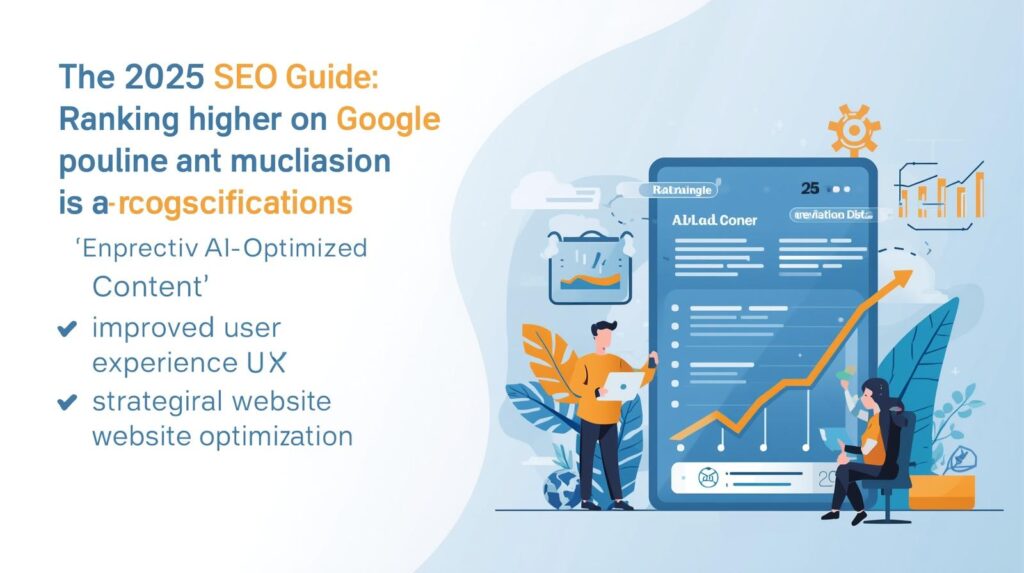SEO Tips 2025 Boost Your Website to the Top

SEO (Search Engine Optimization) has never stood still, and 2025 is no exception. With Google’s Search Generative Experience (SGE) expanding worldwide and AI-driven algorithms becoming increasingly sophisticated, ranking a website now requires a thoughtful balance of technical expertise, high-quality content, and user-first strategies. Whether you manage a small blog or a large e-commerce store, these up-to-date tips will help you climb search rankings and stay there.These SEO tips for 2025 will help you climb search rankings and stay there.
1. Build a Solid Technical Foundation
Great content can’t perform if your site loads slowly or has broken links. Start with a technical audit:
-
Core Web Vitals: Optimize Largest Contentful Paint (LCP), First Input Delay (FID), and Cumulative Layout Shift (CLS). Fast, stable pages improve user experience and satisfy Google’s page-experience signals.
-
Mobile-First Design: With most searches coming from smartphones, your website must be responsive. Test layouts across different devices and screen sizes.
-
Clean Architecture: Create a logical site hierarchy, using descriptive URLs and an XML sitemap so search engines can crawl and index pages efficiently.
-
HTTPS Security: A secure connection (SSL certificate) is non-negotiable for both trust and ranking.
2. Master Keyword Research—With Intent in Mind
In 2025, keyword research is about understanding intent rather than stuffing pages with phrases.
-
User Intent: Identify whether a searcher wants information (informational), is comparing options (navigational), or ready to purchase (transactional). Match your content format to that intent.
-
Long-Tail Opportunities: Tools like Google Keyword Planner, Ahrefs, or SEMrush reveal lower-competition phrases. Long-tail keywords capture highly qualified visitors who are closer to converting.
-
Semantic SEO: Search engines look for context. Incorporate related phrases, synonyms, and entities naturally within your content to cover a topic comprehensively.
3. Create High-Quality, Helpful Content
Google’s Helpful Content Update continues to reward pages that truly serve readers. Focus on: Great content remains the foundation of effective SEO.
-
Depth and Authority: Offer in-depth answers, expert opinions, and data-backed insights. Aim to become the go-to resource for your niche.
-
Freshness: Update key articles regularly with new statistics, examples, or industry trends to signal ongoing relevance.
-
Multimedia Value: Blend text with images, charts, short videos, or infographics to increase time on page and engagement.
-
E-E-A-T: Demonstrate Experience, Expertise, Authoritativeness, and Trustworthiness. Clear author bios, citations, and transparent sourcing build credibility.

4. Optimize On-Page Elements
Search engines still rely on clear on-page signals:
Compelling Titles & Meta Descriptions: Write concise, keyword-rich titles under 60 characters and engaging descriptions under 160.
Header Tags (H1–H3): Use a logical structure that guides readers and search crawlers alike.
Internal Linking: Link related articles and key service pages to spread link equity and help users navigate.
Image SEO: Add descriptive alt text and compress images for fast loading without sacrificing quality.
5. Build High-Quality Backlinks
Backlinks remain a major ranking factor, but quality outweighs quantity.
Guest Posts & Thought Leadership: Contribute expert articles to reputable industry sites.
Digital PR: Share original research or unique insights that journalists and bloggers naturally reference.
Partnerships & Mentions: Collaborate with complementary businesses for mutually beneficial links.
Avoid spammy link farms or paid networks; they can trigger penalties that are hard to recover from.
6. Prioritize User Experience (UX)
Google’s AI can measure how visitors interact with your site.
Intuitive Navigation: Keep menus simple and ensure key pages are reachable within three clicks.
Fast Load Times: Compress images, use a content delivery network (CDN), and enable browser caching.
Accessibility: Use clear contrast, readable fonts, and ARIA labels so everyone—including users with disabilities—can navigate easily.
Engaging CTAs: Encourage action with clear calls-to-action that guide readers toward subscriptions, downloads, or purchases.
A seamless UX lowers bounce rates, a key metric that positively impacts your SEO.
7. Embrace AI and Voice Search
As voice assistants and AI chat interfaces become routine, optimize for natural language queries.
Conversational Phrases: Include question-and-answer sections that reflect how people speak.
Structured Data Markup: Implement schema for products, events, and FAQs to help search engines display rich snippets and improve click-through rates.
Content for SGE: Google’s generative AI surfaces concise, trustworthy answers. Ensure your content is factual, well-cited, and easy for AI to summarize.
8. Monitor Performance and Adapt
SEO is ongoing, not a one-time project.
Analytics & Search Console: Track traffic, impressions, click-through rates, and index coverage.
A/B Testing: Experiment with headlines, layouts, and calls-to-action to improve engagement.
Competitive Analysis: Regularly review what top competitors are ranking for and adjust your strategy accordingly.
9. Technical SEO for 2025
Technical SEO ensures your site can be efficiently crawled and indexed. Focus on:
Core Web Vitals: Largest Contentful Paint (LCP), First Input Delay (FID), and Cumulative Layout Shift (CLS).
Clean XML sitemaps and accurate robots.txt files.
Canonical tags to avoid duplicate content.
HTTPS security for credibility and higher SEO scores.
Proper use of structured data for rich snippets.
Final Thought
Ranking high in search results is no longer about gaming algorithms; it’s about delivering an outstanding experience for real people. A well-optimized site, grounded in helpful content and supported by strong technical foundations, earns trust from both users and search engines.
By implementing these 2025-ready strategies—technical excellence, intent-driven keywords, authoritative content, user-centric design, and continuous optimization—you’ll give your website the best chance to rise above the noise and secure a lasting spot at the top of the search results.



